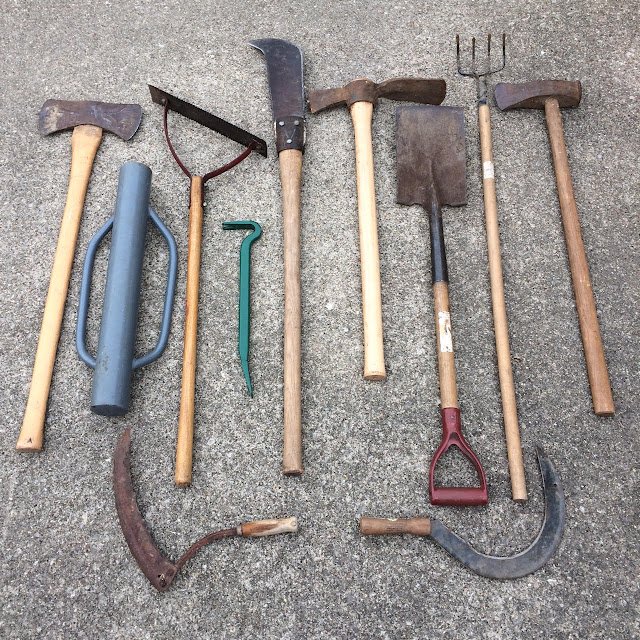 |
Þursastafir
|
We come from squalor
with good intentions. Our given paths were not meant to sustain
themselves and The End was easier to visualize than The Future, thus we
fled to The Hedge in an effort to explore both realms. Among
The Day, we learned to raise organic crops & cultivate healthy
composts in
small urban gardens, forage for wild foods & adapt our palates to
them, balance nutrient intakes to best energize ourselves for the labor
& activity we came to engage and provide for ourselves with a
minimal need for
currency-based consumption using that labor & activity. Upon
Nightfall, we contemplated the means to apply safe travel & leave no
traces, honed multiple crafts into tools & toys to better protect
& entertain us along that road and wondered what success might be
like somewhere along it. We became aware of the concept of Non-Dualism
and now attempt a dance between physical & mental states to
empower our thoughts & deeds that may seek unity & justice.
We
have had fortune with guidance & confidence by using the Elder
Fuþark to interpret concepts like coincidence, luck and fortune.
However, to explore the foundation of behavior that define the
popularly believed origins of those things presented very direct
parables of destroying nature for vanity, sport, title & class.
Abruptly opposed to such ideas, our studies with The Runes also began to
unify with Their Reflections. Parallels with Kabbalah began finding us and we were pierced by the concept of Sitra Achre, where
They of The Other Side inspire an inverted view of the runic structure
within a numerological context and provide methodology for totemic
visualizations. During this practical shift, we would discover &
devote ourselves to Thursatru, a
neo-pagan alignment with the perspective of adversarial
characters among pre-christian Celtic & Norse folklore. Eventually,
we came to practice & create a veneration of primitive spirituality based around
The Essence of Nature, Forms It has been seen & known to have taken
and The Ekstasis by which we experience thru Their Presence. We would soon also be found
by Kali-Ma while developing yogic rituals, Tezcatlipoca while practicing
self-defense, Phur Pa while using & caring for tools and Kehlen
while learning herbalism & wildcraft. We are able to See &
Commune with our Family when we can perceive Them as They Are within
living constructs of this reality's physical world and we make a
priority of our work to honor & respect that Lineage.
"Reka Spor" means to follow tracks. The Ancestry we identify with is Feral, Virile, Alive & Among us and our devotion is grounded in how we observe & bond with Them. There are many acts by which we explore that piety, but several are large foundational stones to how we project our spirituality into the worlds we consciously engage.
Blota
refers to an act of Worship, from a simple awareness of Hamingja & Galdr in it's honor to fully coordinated ritual ceremonies. Theophagy
is a practice where one aligns themselves with a spiritual essence by
consuming aspects relative to that essence. As agricultural
journeyfolk, our first step into a farm or garden begins the effort to
raise foods that become richly bioactive with
relationships to our Lineage and allows us to worship as long as we can
continue our work to feed ourselves.
Muna refers to memory, more
specifically A or The Remembrance, which we understand as a cause of
impact triggering a memory. Gnosticism believes in the dissolution of
ego to free the id for transition between realms/worlds/verses, allowing
a perception of experiencing or working among any moment in any time or
place within them. As animists, we contemplate from Their perspective & history
before our own and can imbue our work with an intention for the health
& well-being of Their World in search of the luck & fortune to
have It be remembered first.
Banii refers to The Bringer of Death; That which brings or has brought about an
End. Hedgecraft collects the very expanse of norse cosmology within Itself and thrives with contribution while providing majestically extensive means to create it. As
anarcho-primitivists, we seek to define our own culture, belief &
unity around an opportunity for anyone to make possible Their own future
that ends as much on Their own terms as can be made for with limited residual impact on the world behind Them.
BMB: Worship, In Remembrance, The Bringer of Death.
Perhaps if we focus on how we are most likely to end, we have an opportunity to create a more enjoyable path toward it.
Traveling along The Left Hand Path is publicly controversial as many
stops & routes along the way are in direct conflict with ideas
presented by orthodox religion, federated governments & popular
commerce, who forcibly suggest cartoonish villainy among any idea contrary to theirs and shift their work to secular advances of suppressing opposition. BMB does not consent to generalized projections of
intention based on our travels, physical & astral, our work,
physical & esoteric, or our appearance, actual & perceived. Our
Lineage is full of wonder and They are more important than any federation or government, so we are often thrilled to discuss
practical ideas & methods to speak & work with Them to better connect the identity we might share Together in a place where They can run as free as we would see ourselves.
We hereby make ourselves available for discussion, consultation & service. Details for all those potentials are imminent.
Our mental faculties are in good order. Only Emptiness can be filled with divinity.
...


















